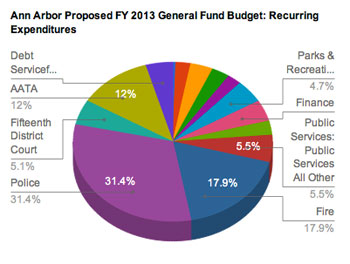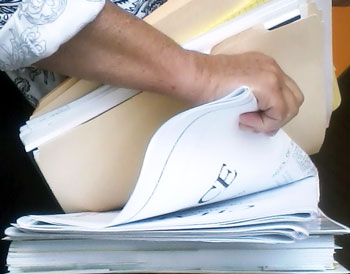At the Ann Arbor city council’s April 16, 2012 meeting, city administrator Steve Powers presented the Ann Arbor city council with his proposed budget for fiscal year 2013, which begins on July 1, 2012. He described the current situation as one where the city has emerged from the crisis of the last few years and is ready to return its focus to “sustaining our future.”
The total expenditure budget for FY 2013 – across all funds, including utilities, solid waste and the like – is proposed at $404,900,312 in revenues against $382,172,603 in expenses.

About half of the recurring expenditures in the proposed FY 2013 budget for the city of Ann Arbor general fund are made up by safety services – police and fire. (Image links to Google spreadsheet.)
The proposed budget for the much smaller general fund – out of which the city pays for services like fire and police, planning, financial services, administration, parks and recreation – shows $79,193,112 in revenues against expenses totaling $78,869,750 for a planned surplus of $323,362. The following year, FY 2014, is currently projected to be basically a break-even year.
That’s similar to the picture that chief financial officer Tom Crawford had sketched out for the city council at a Feb. 13, 2012 work session. But he’d projected close to $1 million in net surplus – which included $1.6 million in surplus on the recurring revenue and recurring expenses side.
So the city administrator’s budget includes some additional one-time, non-recurring expenses as well as some additional costs, compared to Crawford’s February sketch. An example of a greater recurring cost is the settlement of the firefighters union contract. A more frequent mowing cycle in the parks – every 14 days instead of every 19 days – is an additional cost. An example of an additional non-recurring cost is an allocation for the local matching portion of the High Speed Intercity Rail project – the city’s current nomenclature for the Fuller Road Station, while the final site determination of such a station is still pending.
With some notable exceptions in police and fire, the proposed FY 2013 budget mostly reflects the planning done a year ago when the FY 2012 budget was adopted. (Although the city of Ann Arbor adopts annual budgets, it plans in two-year cycles.)
Highlights of the proposed FY 2013 budget that are different from the two-year plan include the addition of one police officer instead of eliminating nine positions (for an additional cost of $1,038,167). Staffing for the police department as a whole, however, will include a reduction of 19 dispatcher positions, because the city is now contracting with Washtenaw County for dispatch services. In the city administrator’s budget message to the council, the savings due to the outsourcing of dispatch operations are identified as $1,238,297. Also identified in the budget message are $477,000 in savings from labor contract settlements with the police unions.
The proposed budget also calls for maintaining the budgeted staffing for the fire department at 82 firefighters, instead of reducing firefighter positions by five positions (for an additional cost of $584,000). The recent contract settlement with the firefighters union is listed as a $229,000 additional cost – firefighters are being paid to work more hours. However, $657,000 in additional revenues to the fire department are also identified – due primarily to increased inspections and the fees associated with that. At the March 12 work session when fire chief Chuck Hubbard presented a new, three-station coverage model to the city council, he stated that he felt the ideal number of firefighters for the Ann Arbor department would be 88 firefighters.
In terms of utility rates, the drinking water, sanitary sewer, and stormwater fees are proposed to increase between 3.25% to 4.25%.
According to Ann Arbor’s city charter, the city administrator must present the city council with a proposed budget for the next fiscal year at its second meeting in April, which fell on April 16 this year. The city council then must make any amendments to the proposed budget by the second meeting in May. This year that falls on May 21. Public hearings on the budget and associated fee changes will be held at the council’s May 7 meeting. [Full Story]






